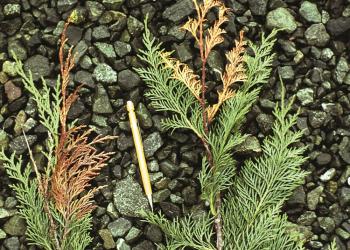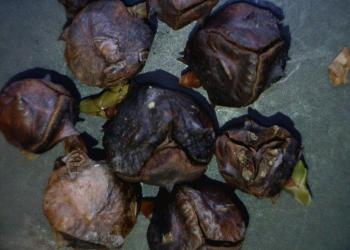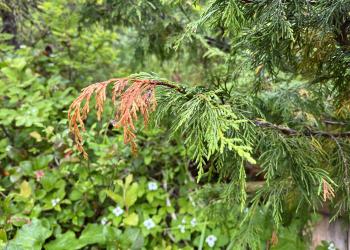Yellow-Cedar Shoot Blight
Kabatina thujae Schneider & Arx
Host(s) in Alaska:
yellow-cedar (Callitropsis nootkatensis)
Habitat(s): terminal and lateral shoots of yellow-cedar (occassionally cones)
General Distribution in Alaska: Southeast Alaska
Yellow-cedar shoot blight (Kabatina thujae) incidence and severity has been elevated in natural forest and landscape settings across Southeast Alaska in recent years. Disease levels were particularly high at a yellow-cedar common garden planting site north of Juneau. It is likely that the disease at the study site arrived on seedlings planted in 2010 and intensified under favorable conditions and high host density, rather than spreading from small, natural yellow-cedar populations around Juneau. The common garden trial allows for comparison of heritable characteristics (such as survival, growth rate, cold tolerance, and susceptibility to deer browse or disease) among the 16 yellow-cedar seedlots that were planted. The seedlots were sourced from Southeast Alaska and all 100 trees within each seedlot originated from the same parent tree.
In June, we remeasured the yellow-cedars and rated yellow-cedar shoot blight disease severity. While tree survival was very high (94%), shoot blight occurred on most live trees and more than half had topkill from shoot blight. Six disease severity ratings were assigned to live trees, corresponding to the percentage of shoots impacted by disease: 0 (no disease, 4% of trees), 1-3% (very low, 25% of trees), 4-10% (low, 31% of trees), 11-20% (moderate, 22% of trees), 21-40% (high 11% of trees), and >40% (very high, 6% of trees). We will continue to evaluate whether disease severity levels or tree heights are significantly different between seedlots. Moving forward, prevalent disease at this site may help us to understand how yellow-cedar shoot blight impacts longer-term tree survival and growth form.
2024 Ground Detection Survey Observations: 20 on Mitkof, Kupreanof, Wrangell, and Revillagigedo Islands.
2024 iNaturalist Observations: None.
Lateral shoots and leaders of yellow-cedar seedlings and saplings typically die from this disease in early spring, though most trees recover. Long-term tree structure is not thought to be compromised by leader infections. This disease is widespread throughout the range of yellow-cedar in Southeast Alaska, but less is known about its prevalence among Prince William Sound populations (see Detection Map).
In 2018, we received samples of yellow-cedar cones infected with a fungal pathogen on Prince of Wales Island near Naukati. Dr. Jane Stewart at Colorado State University identified Kabatina thujae as the causal pathogen. Although this fungus commonly causes shoot blight, damage to cones had not been previously documented in Alaska.
Fungal databases, such as the Global Biodiversity Information Facility, report that this pathogen has also been documented in France, Great Britain, the Netherlands, and New Zealand. This database excludes British Columbia and Alaska as locations with this disease.
Yellow-cedar shoot blight is frequently noted in young-growth stands of Southeast Alaska that contain yellow-cedar. The disease is also observed in British Columbia. Prior to 2013, the identity of the causal pathogen in Alaska was not known (it was tentatively called Apostrasseria sp.). Elevated disease activity in Southeast Alaska was noted in 2008, 2014 and 2015.
Terminal and lateral shoots on seedlings and saplings become infected and die during late winter or early spring. Symptoms of this disease are sometimes confused with spring frost damage. Dieback may extend 4 to 10 inches from the tip of the shoot. Sometimes entire seedlings up to 2 feet tall are killed. The long-term tree structure of taller saplings is not thought to be compromised by leader infections.
In 2013, some infections were observed on deer-browsed shoots. Dr. Jeffery Stone at Oregon State University and University of Oregon confirmed the identity of the causal fungus as Kabatine thujae from collections made in 2013. This pathogen is known to damage natural and ornamental yellow-cedar saplings in British Columbia. More work is needed to determine if this is the only shoot blight pathogen that causes widespread damage to yellow-cedar young-growth in Southeast Alaska.

Disease severity and distribution information primarily comes from informal ground observations from Forest Health Protection staff and land managers. In 2024, 1,600 yellow-cedars trees planted in 2010 in a common garden study near Juneau were remeasured and rated for yellow-cedar shoot blight disease severity. Shoot blight occurred on most live trees and more than half had topkill from shoot blight. Six disease severity ratings were assigned to live trees, corresponding to the percentage of shoots impacted by disease: 0 (no disease, 4% of trees), 1-3% (very low, 25% of trees), 4-10% (low, 31% of trees), 11-20% (moderate, 22% of trees), 21-40% (high 11% of trees), and >40% (very high, 6% of trees).
Content prepared by Robin Mulvey, Forest Health Protection, robin.mulvey@usda.gov.













